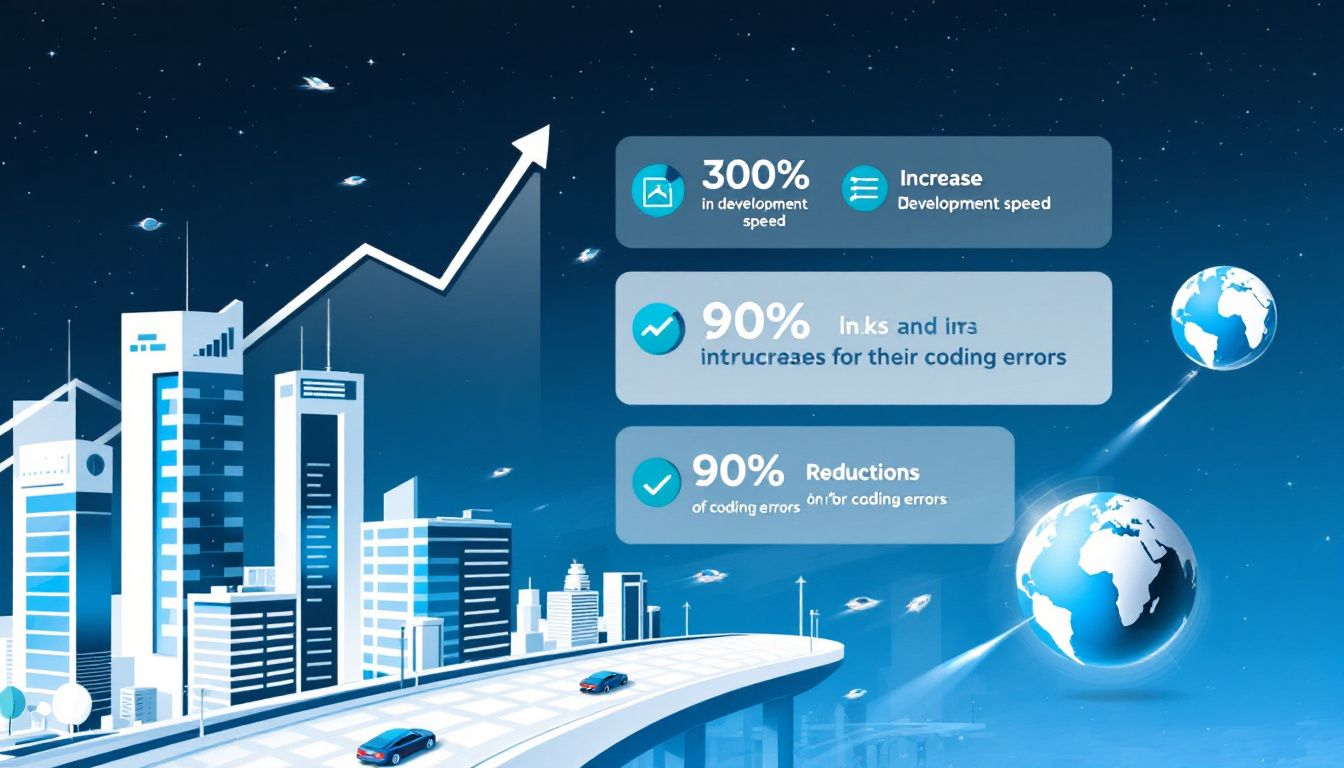

Mastering Low-Code Scalability: Tips for Optimal Performance
Published on January 13, 2025
By Jaren Hidalgo · 12 minute read
Can Low-Code platforms handle growing demands effectively? Low-Code scalability ensures that as your application needs expand, these platforms can manage higher workloads without losing performance. In this article, we’ll explore the crucial aspects of scalability in Low-Code development and provide actionable tips for optimizing performance and maintaining responsiveness.
Key Takeaways
Low-Code scalability enables rapid deployment and efficient handling of increased workloads without performance degradation, significantly lowering development costs.
Key factors influencing Low-Code scalability include APIs, microservices architecture, and thorough platform documentation, which facilitate data sharing and seamless collaboration.
To achieve enterprise-level scalability, organizations should adopt a hybrid model that combines Low-Code development with traditional programming practices, enhancing responsiveness and customization.
Understanding Low-Code Scalability

Scalability in Low-Code development platforms refers to the ability to handle higher workloads without performance loss. This is a critical factor for businesses looking to deploy applications rapidly and efficiently. Low-Code development promotes faster returns on investment due to quicker development times and reduced costs, making it essential for scalable application solutions. As user demands increase, Low-Code platforms must adapt seamlessly, ensuring that applications remain performant and responsive.
The elimination of traditional application development process significantly reduces scalability costs. This is where the power of Low-Code tools shines—by enabling business users to develop software solutions without extensive coding skills, these platforms facilitate scalability through automation. The speed at which Low-Code applications can be created and deployed—often in less than a month—further enhances their scalability. With drag-and-drop interfaces, Low-Code app development enables quick prototyping and deployment, which is crucial for maintaining performance under varying demands.
Understanding and managing scalability requires evaluating platform documentation. Comprehensive documentation ensures efficient tracking and transparency, aiding in project management and change tracking. This foundation sets the stage for deeper exploration into the key features that influence scalability and how to measure it effectively.
What is Low-Code Scalability?
Low-Code scalability refers to the ability of a Low-Code platform to handle increased workloads, user demands, and complex transactions without compromising performance. This capability is crucial for businesses aiming to scale their applications efficiently while adapting to changing requirements and growing user bases. By leveraging Low-Code scalability, organizations can maximize their return on investment (ROI) and maintain a competitive edge in the market. A robust Low-Code platform ensures that applications remain responsive and performant, even as they scale to meet higher demands.
Benefits of Low-Code Scalability

The benefits of Low-Code scalability are numerous:
Increased Efficiency: Low-Code platforms automate repetitive tasks, reducing manual coding efforts and enabling developers to focus on high-value tasks. This automation streamlines the development process, making it more efficient and less time-consuming.
Faster Time-to-Market: With Low-Code scalability, businesses can quickly develop and deploy applications, responding to changing market demands and staying ahead of the competition. The rapid development cycle of Low-Code platforms ensures that new features and updates can be rolled out swiftly.
Improved Customer Experience: Scalable Low-Code applications ensure a seamless user experience, even under heavy loads, leading to increased customer satisfaction and loyalty. By maintaining performance during peak usage times, businesses can provide a consistent and reliable service to their users.
Cost Savings: Low-Code scalability reduces the need for extensive coding expertise, minimizing development costs and enabling businesses to allocate resources more effectively. The reduced reliance on traditional coding methods translates to significant cost savings in both development and maintenance.
Enhanced Collaboration: Low-Code platforms facilitate collaboration between developers, business users, and stakeholders, promoting a culture of innovation and agility. The intuitive drag-and-drop interfaces and visual tools make it easier for all team members to contribute to the development process.
Limitations of Low-Code Scalability
While Low-Code scalability offers numerous benefits, there are some limitations to consider:
Performance Bottlenecks: Highly customized Low-Code solutions can introduce performance bottlenecks, impacting application scalability. As applications become more complex, the underlying platform may struggle to maintain optimal performance.
Platform Dependency: Businesses may become dependent on the Low-Code platform, limiting their ability to switch vendors or migrate to alternative solutions. This dependency can pose challenges if the platform fails to meet evolving business needs.
Long-term Maintenance Costs: Low-Code platforms require ongoing maintenance and updates, which can lead to increased costs over time. While initial development may be cost-effective, the long-term expenses associated with platform upkeep should be considered.
Debugging Challenges: Debugging Low-Code applications can be more complex due to the abstracted nature of the platform. The visual development environment may obscure underlying issues, making it harder to identify and resolve bugs.
Key Features Influencing Scalability
APIs serve as a bridge for data sharing between applications, crucial for scalable Low-Code solutions. APIs facilitate communication between applications, significantly impacting the scalability of Low-Code platforms. This seamless data exchange ensures that applications can handle increased workloads without performance bottlenecks.
Microservices architecture is another critical feature that enhances scalability by breaking applications into manageable services. This modular approach allows developers to scale individual components independently, improving overall system performance.
Additionally, a flexible data architecture supports concurrent application development by multiple users, further boosting scalability.
Evaluating Platform Documentation
Comprehensive documentation is crucial for scaling Low-Code platforms as it ensures efficient tracking and transparency. Proper documentation helps teams understand the architecture and dependencies involved, leading to better project management transparency. This clarity is essential for managing changes and ensuring that all modifications are tracked efficiently.
Detailed documentation empowers developers and business users with easy to use tools navigate the development framework effectively. This accessibility ensures that all stakeholders can contribute to the development process, facilitating smoother scalability and more cohesive project outcomes.
Measuring Scalability in Low-Code Platforms

Evaluating performance under varying workloads and analyzing adaptability are key to measuring scalability in Low-Code platforms. Organizations can assess scalability by reviewing case studies and examining how Low-Code development platforms handle increased user demands. The ongoing costs of Low-Code platforms, including subscription fees, technical support and services, and costs for scaling and customization, also play a significant role in scalability.
Reduced development times and lower labor costs make Low-Code development platform more cost-effective compared to traditional software development. Companies using Low-Code solutions often achieve significant reductions in development time and costs. This cost-effectiveness, combined with the ability to automate business processes quickly, makes Low-Code platforms an attractive option for scalable Low-Code application development, resulting in significant cost savings.
Runtime Scalability Metrics
Runtime scalability refers to the overall performance of applications in Low-Code platforms. Pre-built connectors and APIs facilitate communication between applications and enable data sharing, ensuring that Low-Code applications remain responsive during peak usage. Distributing services across multiple servers allows Low-Code platforms to maintain high reliability and efficiency for CPU-intensive operations, ensuring optimal performance.
Mendix, for example, ensures high reliability and efficiency in its Low-Code platform, highlighting the importance of runtime scalability metrics in maintaining operational efficiency and overall performance.
Dev-Time Scalability Metrics
Dev-time scalability can be assessed by evaluating onboarding time and the collaboration between professional and non-technical developers in development team. Effective collaboration across roles is crucial for ensuring that Low-Code solutions meet diverse user needs and expectations. Shorter development cycles in Low-Code platforms enable rapid prototyping and quick iterations, enhancing overall performance.
User feedback and advanced analytics play a pivotal role in refining Low-Code solutions for citizen developers. Continuous feedback loops and visual tools help developers ensure that applications evolve to meet changing business requirements, enhancing scalability and performance.
Designing for Scalability
To ensure Low-Code scalability, it’s essential to design applications with scalability in mind. This involves:
Modular Infrastructure: Breaking down applications into smaller, independent modules enables easier maintenance, updates, and scaling. This approach allows businesses to manage each component separately, ensuring that changes in one module do not affect the entire application.
Microservices Architecture: Implementing a microservices architecture allows for greater flexibility and scalability, as individual services can be scaled independently. This modular approach ensures that each service can be optimized for performance and scaled according to demand.
Cloud-based Deployment: Deploying applications on cloud-based infrastructure enables easy scaling, high availability, and reduced maintenance costs. Cloud platforms offer the flexibility to scale resources up or down based on usage patterns, ensuring that applications remain performant.
API-based Integration: Using APIs for integration enables seamless communication between applications and services, promoting scalability and flexibility. APIs allow different systems to interact efficiently, ensuring that data flows smoothly across the application ecosystem.
Modular Infrastructure
A modular infrastructure is a critical component of Low-Code scalability. By breaking down applications into smaller, independent modules, businesses can:
Simplify Maintenance: Modular infrastructure makes it easier to maintain and update individual components, reducing the risk of application downtime. Each module can be managed separately, allowing for targeted updates and improvements.
Improve Flexibility: Modular infrastructure enables businesses to add or remove components as needed, promoting flexibility and adaptability. This approach allows organizations to respond quickly to changing requirements and scale specific parts of the application as needed.
Enhance Scalability: Modular infrastructure allows for easier scaling, as individual components can be scaled independently to meet changing demands. This ensures that the application can handle increased workloads without compromising performance.
By designing applications with scalability in mind and leveraging modular infrastructure, businesses can unlock the full potential of Low-Code scalability and achieve greater efficiency, agility, and competitiveness in the market.
Strategies for Achieving Enterprise-Level Scalability

Enterprise-level scalability requires a strategic approach combining Low-Code development with traditional programming. Low-Code platforms empower organizations to create applications quickly, enhancing their ability to respond to market demands and improving data visibility. Businesses are increasingly turning to Low-Code automation platforms to automate workflows and enhance experiences, which is essential for sustaining operations effectively.
Integrating Low-Code with traditional coding and traditional programming helps businesses achieve faster time-to-market and high-quality enterprise-grade applications. This hybrid approach leverages the strengths of both methodologies, ensuring that they develop applications that are both scalable and robust.
Customization Capabilities
Customization capabilities are essential in Low-Code platforms as they enable organizations to tailor applications to complex business requirements. Low-Code platforms provide a range of customization options, including the ability to modify existing code, incorporate custom UI components, and use extensibility options for deeper customization. These capabilities ensure that applications can meet specific business needs while maintaining scalability.
Many Low-Code platforms include pre-built templates and reusable components, which streamline the process of creating complex business processes and accelerate development. Custom UI components in Low-Code platforms improve user experience and application functionality, enabling non-technical users to engage effectively with the system.
Agile Project Management
Integration with DevOps processes and CI/CD pipelines enhances project management in Low-Code platforms. The integration of DevOps practices leads to efficient software delivery and easier updates, promoting agile development methodologies. This agility is crucial for maintaining scalability in dynamic business environments.
Rapid prototyping in Low-Code platforms allows developers to quickly build, test, and refine applications, enhancing agility and responsiveness to changing requirements. The ability to make quick changes and easily add new features further promotes agile practices, ensuring that Low-Code solutions can scale effectively.
Overcoming Common Scalability Challenges

Many businesses experience issues with current workflow automation and management tools, which are often slow, manual, and prone to errors, disrupting organization. Addressing these challenges is crucial for achieving scalability. Establishing a Center of Excellence can significantly improve the governance and maintenance of the automation program. This centralized approach ensures that scalability efforts are cohesive and well-coordinated.
Low-Code platforms can help reduce project timelines, allowing for faster deployment and response to changing business needs. However, traditional scalability in software development faced challenges such as complexity, resource-intensiveness, and high requirements for time, expertise, and financial investment. Overcoming these challenges requires a strategic approach that leverages the strengths of Low-Code development.
Handling Complex Business Logic
Low-Code platforms support scalability through built-in features. These include load balancing, resource allocation, and performance monitoring. Many Low-Code platforms are equipped to manage complex business processes, cases, tickets, and workflows effectively. This capability ensures that even sophisticated business logic can be handled without extensive manual coding.
Platforms like Kissflow enforce standard processes, preventing loss or errors during process management. Low-Code platforms simplify the management process automation of complex business logic through advanced customization and integration features, ensuring that applications remain scalable and efficient.
Ensuring Security and Compliance
No-Code platforms are not immune to security and compliance issues, which need to be actively addressed. Built-in security features in modern Low-Code platforms typically include advanced encryption and role-based access controls. These measures ensure that sensitive information is protected, and access rights are managed effectively.
Ensuring compliance with data protection regulations is also a priority for Low-Code platforms. Implementing robust security protocols and conducting regular audits help businesses maintain transparency and safeguard customer data. This proactive approach is essential for maintaining trust and compliance in a rapidly evolving regulatory landscape.
Case Studies: Successful Low-Code Scalability

Evaluating scalability involves assessing performance under varying workloads and reviewing relevant case studies. A significant percentage of enterprise developers, approximately 87%, utilize Low-Code automation tools for part of their development tasks, highlighting the growing adoption of these platforms. Case studies provide valuable insights into how Low-Code solutions can scale effectively in real-world scenarios.
Low-Code solutions are increasingly being embraced in industries with stringent regulatory compliance, such as finance and healthcare. These case studies demonstrate the potential for Low-Code platforms to enhance scalability and operational efficiency across legacy systems in various sectors.
Enterprise Success Stories
A leading financial services firm improved customer relationship management by developing a unified platform within two months using Low-Code tools. This rapid development and deployment showcased the scalability and efficiency of Low-Code platforms. Unilever’s mobile sales application improved the sales process and enriched customers’ experiences, further demonstrating the benefits of Low-Code scalability.
Enterprises across various sectors, such as finance, healthcare, and e-commerce, are increasingly turning from traditional development and to Low-Code platforms to enhance their scalability and operational efficiency. These success stories highlight the transformative potential of Low-Code solutions in diverse industries.
Industry-Specific Examples
No-Code solutions enable high-tech businesses to create intuitive, responsive, and feature-rich applications. These platforms enhance customer engagement by creating user-centric applications that meet the unique needs of each industry. The high-tech sector, in particular, faces unique scalability challenges that require innovative solutions. Leveraging Low-Code platforms allows these businesses to address challenges effectively and maintain a competitive edge using a No-Code platform.
The scalability of Low-Code solutions is not limited to the high-tech sector. Industries such as finance, healthcare, and e-commerce also benefit significantly from these platforms. By streamlining business processes and enhancing operational efficiency, Low-Code platforms help businesses in these sectors to scale their applications and meet growing demands.
Future Trends in Low-Code Scalability
By 2025, it is anticipated that 70% of new applications will be developed using Low-Code or No-Code technologies. This growth underscores the increasing flexibility and customization options expected in Low-Code platforms. The evolution of No-Code platforms promises increased accessibility and reduced complexities, making tech development easier for both developers and business users. Additionally, No-Code tools are becoming essential in this landscape.
As Low-Code platforms become more scalable, they will also become more integrated with existing systems and emerging technologies. This integration will enhance the development of complex enterprise solutions and ensure that Low-Code applications remain relevant and competitive in a rapidly changing technological landscape.
Integration with Emerging Technologies

The future of Low-Code platforms lies in their ability to seamlessly integrate with advanced technologies, enhancing the development of complex enterprise solutions with minimal coding alone. Low-Code development is anticipated to significantly incorporate emerging technologies like artificial intelligence and machine learning within enterprise applications. This integration will enable businesses to create more sophisticated and intelligent applications without extensive coding knowledge.
The integration of DevOps practices with Low-Code platforms will also accelerate software delivery and simplify updates. Seamless integration with IoT, AI, and other software will enhance product offerings, ensuring Low-Code platforms continue to drive digital transformation and remain relevant.
Continuous Evolution and Feedback Loops
Continuous evolution and feedback loops are essential for refining Low-Code solutions and ensuring they meet diverse user needs and expectations. Driven by continuous feedback from diverse users and advanced analytics, Low-Code platforms can adapt and evolve to address emerging requirements. This adaptability is crucial for maintaining scalability and ensuring optimal performance.
Rapid prototyping in Low-Code platforms facilitates quick iterations, allowing developers to refine applications efficiently. By incorporating continuous feedback and advanced analytics, businesses can enhance the overall scalability and performance of their Low-Code applications, ensuring they remain robust and responsive to changing demands.
Summary
In summary, mastering Low-Code scalability involves understanding the core principles of scalability, utilizing key features like APIs and microservices, and evaluating comprehensive platform documentation. Measuring scalability through runtime and dev-time metrics, and employing strategies like customization capabilities and agile project management, are essential for achieving enterprise-level scalability.
By overcoming common challenges related to complex business logic and ensuring security and compliance, businesses can leverage Low-Code platforms to enhance their scalability and operational efficiency. As the adoption of Low-Code technologies continues to grow, integrating with emerging technologies and maintaining continuous evolution through feedback loops will be crucial for staying competitive. Embrace these strategies to unlock the full potential of Low-Code scalability and drive your business towards success.
Frequently Asked Questions
Is Low-Code only suitable for simple applications?
Low-Code platforms are not limited to simple applications; they are capable of doing repetitive tasks and developing enterprise-level and complex system infrastructures. This versatility allows organizations to address a wider range of technological needs efficiently.
Do Low-Code platforms deliver low-quality applications?
No, Low-Code platforms can deliver high-quality applications by prioritizing clean source code and minimizing technical debt.
Can only non-developers work with Low-Code?
No, both non-developers and professional developers can effectively use Low-Code platforms, with developers capable of building more intricate applications and integrating external systems with custom code.
Can Low-Code handle complex business logic?
Yes, Low-Code platforms can effectively handle complex business logic and provide extensive customization for various components. This flexibility makes them a viable option for businesses with intricate requirements.
Is Low-Code secure enough?
Low-Code platforms are generally secure, incorporating features such as data encryption and role-based access control to enhance security measures. Therefore, they can be considered a viable option for secure application development.
To explore how Low-Code platforms can benefit your organization and enhance your scalability efforts, we invite you to schedule a free call with one of our expert Kreante members. Additionally, visit our blog to stay informed and up-to-date with the latest trends, insights, and developments in the No-Code and Low-Code realm. Discover the potential of these innovative platforms and how they can drive your business forward.

Accélérer le développement logiciel grâce au vibe coding et aux outils d'IA chez Kreante

Kreante : accélérer le développement de vos applications grâce au low-code, à l'IA et au « Vibecoding »




.png)


.svg)
